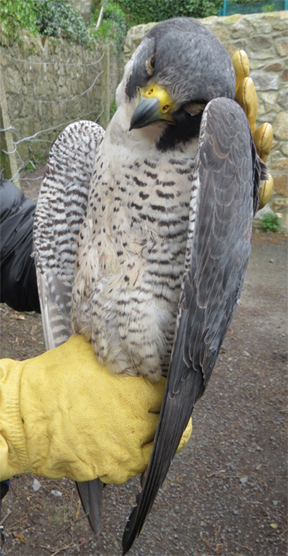| Wildlife
Newsletter for the Township of Dalkey June / 2016 - Michael Ryan |
||
|
When
I saw a text from the Wicklow Wildlife Ranger saying one of the Dalkey
peregrines was dead I was hoping there had been some mistake. We’d
been watching them that afternoon, the pair of peregrines perched
on the same ledge where they had nested in 2006 and 2014. In 2014
they made national news headlines when two racing pigeons coated in
poison were tethered alive near the nest with the intention of killing
the birds and their young. After that I was hoping they’d never
try to nest in the quarry again. In
the intervening years since 2006, possibly because of the fertilising
effect of the accumulated peregrine poo, a thick tussock of grass
had grown on the ledge so earlier this spring, despite occasional
sightings of one of the birds on the ledge there was no definite sign
they had a nest there. But on that early April afternoon when we saw
the two birds near the ledge we were certain they were nesting in
Dalkey Quarry again. The male was perched above the ledge preening
itself, flecks of blood from a recent kill visible on it’s feathers
while the female sat closer to the nest. We watched them for a while
and when we left the scene all was peaceful and calm, nothing indicating
that within 30 minutes the female peregrine would be found lying on
her back on the footpath nearby in obvious distress. |
| He would soon abandon them though because even if the eggs had hatched there would be no chance a single parent would be able to feed and protect any chicks. Ann collected the peregrine’s body, wearing gloves because of the very real concern that the bird might have traces of poison on it. That was the initial suspicion for the bird’s death though worrying reports of a drone being flown erratically in the area raised concern that the bird might have been in a collision with it but Ann had it x-rayed the following day and there was no sign of trauma or fractures. The bird then went to a laboratory for post mortem and testing to see if it had ingested poison. When the results were eventually released it was something of a relief to find that the bird hadn’t been poisoned but seemed to have died of natural causes. It had a number of cysts on its heart and liver but basically it would seem to have died of heart failure. It’s possible it had been the same female that has been nesting in the quarry and other sites for the last ten years, it would have had to be an experienced bird that could raise and fledge four chicks as it did in 2014. It was also a very large bird, the heaviest peregrine that Ann had ever came across. Although peregrines raised in captivity have lived to 25 years, birds in the wild wouldn’t last as long and we can only hope that this bird, after successfully raising many chicks, had reached the natural end of her life. |
 The
dead female peregrine being held by Wildlife Ranger Ann Fitzpatrick The
dead female peregrine being held by Wildlife Ranger Ann Fitzpatrick
Photos: M. Ryan |
||||
|
|||||